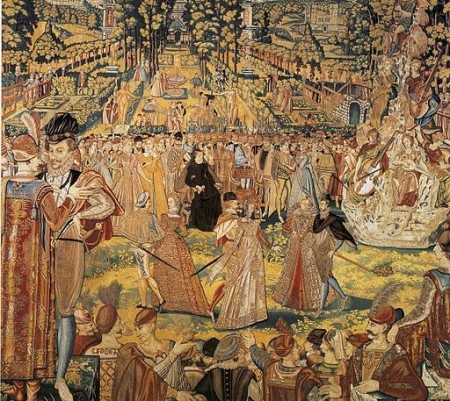First, the distance. Under the best of conditions (good roads, decent weather, level ground), humans can walk four miles per hour over long distances. Horses can’t do much better–maybe five mph—but a lot less if they’re pulling something or if roads are in awful condition. A horse can canter at 20 mph, but it can only do that for six to eight miles at a time, after which it will slow down and walk, or stop completely. So it would have taken a long time to get from place to place. Under the best conditions, a journey from Paris to Chambord would have taken three weeks. But in fact, it took a lot longer than that. Because in the sixteenth century, the royal court didn’t just hop on a horse and head to their country home. They took everything and everyone with them, loading all the stuff onto the backs of horses and mules.
Catherine de Medici traveled with her ladies and gentlemen, foreign ambassadors, dwarves, pet bears, servants, retainers, attendants, apothecaries, astrologists, tutors, musicians, cooking pots, food, clothing, portable triumphal arches, wall hangings, and furniture.
 And second: the reason there were so many castles is simply that the court in Renaissance times –thousands of people–had to move around from estate to estate so as to find new hunting grounds. Once they’d exhausted the food supply in the area, they moved on to the next estate. Also, the sanitation was dreadful. After thousands of people had taken up residence in and around a great estate for a few weeks, filth piled up, and with it, stench and disease.
And second: the reason there were so many castles is simply that the court in Renaissance times –thousands of people–had to move around from estate to estate so as to find new hunting grounds. Once they’d exhausted the food supply in the area, they moved on to the next estate. Also, the sanitation was dreadful. After thousands of people had taken up residence in and around a great estate for a few weeks, filth piled up, and with it, stench and disease.
The royal procession could be miles long. According to Leonie Frieda’s Catherine de Medici, the beginning of the royal caravan sometimes entered a town before those traveling at the back of it had left the last one.

![Ra-smit [GFDL (http://www.gnu.org/copyleft/fdl.html)], via Wikimedia Commons](https://www.sarahalbeebooks.com/wp-content/uploads/2014/08/512px-Chateau_de_Chenonceau_2008E-1-450x241.jpg)